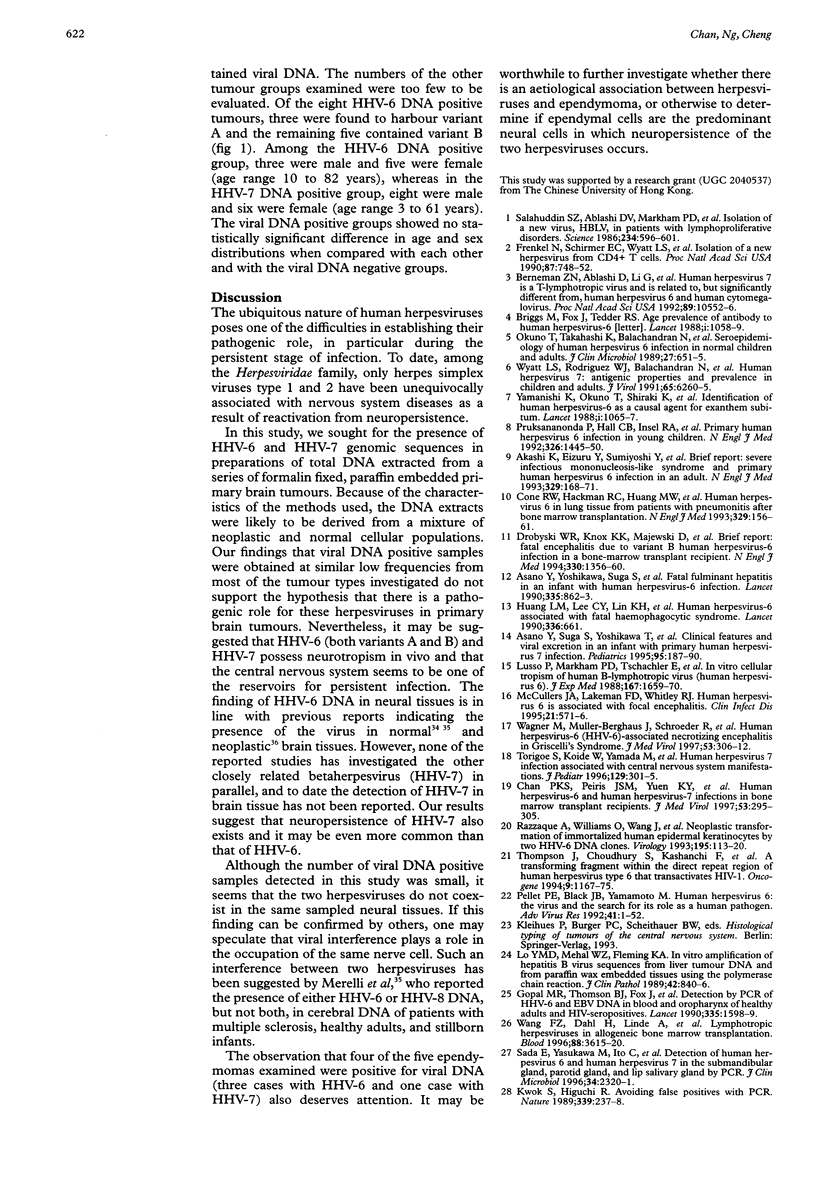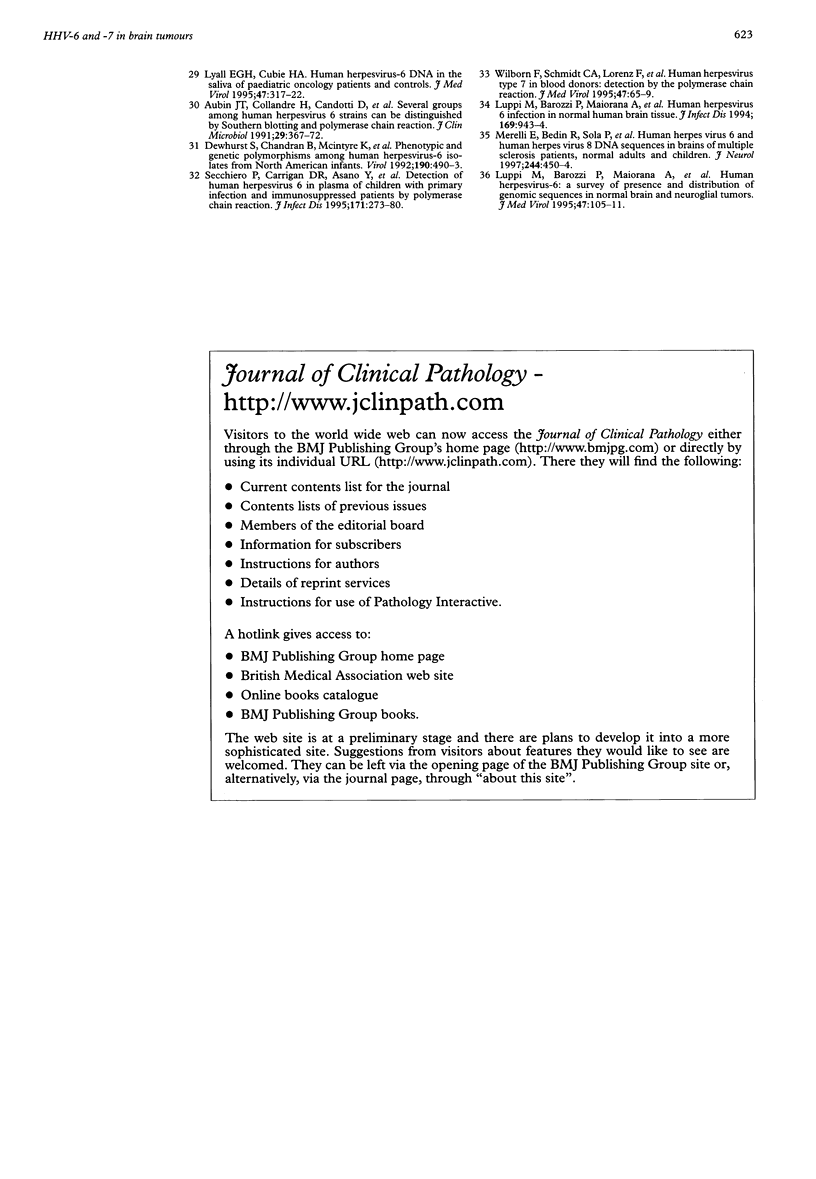Abstract
BACKGROUND: Human herpesviruses 6 and 7 (HHV-6, HHV-7) are ubiquitous, with primary infection occurring early in life followed by persistence, which may involve neural tissue. While HHV-6 and HHV-7 are predominantly T lymphotropic, the extent of tissue tropism in persistent infection is not known. AIM: To investigate neuropersistence and the role of HHV-6 and HHV-7 in brain tumorigenesis. METHODS: Nested polymerase chain reaction was used to detect HHV-6 and HHV-7 genomic sequences in preparations of total DNA extracted from 98 formalin fixed, paraffin embedded primary brain tumours. HHV-6 detected was further characterized into variants A and B by restriction fragment length analysis. RESULTS: HHV-6 was detected in 8.2% of cases and HHV-7 in 14.3% (14/98). None of the positive samples contained both viruses. Among the eight HHV-6 positive tumours, three harboured variant A and five variant B. Four of the five ependymomas studied contained viral DNA. Otherwise, both HHV-6 and HHV-7 were present at similar low frequencies in most of the tumour types investigated. CONCLUSIONS: The findings do not support an aetiological role of HHV-6 and HHV-7 in primary brain tumour, but they suggest that HHV-6 and HHV-7 are neurotropic in vivo and that the central nervous system seems to be one of the reservoirs for persistent infection.
Full text
PDF



Images in this article
Selected References
These references are in PubMed. This may not be the complete list of references from this article.
- Akashi K., Eizuru Y., Sumiyoshi Y., Minematsu T., Hara S., Harada M., Kikuchi M., Niho Y., Minamishima Y. Brief report: severe infectious mononucleosis-like syndrome and primary human herpesvirus 6 infection in an adult. N Engl J Med. 1993 Jul 15;329(3):168–171. doi: 10.1056/NEJM199307153290304. [DOI] [PubMed] [Google Scholar]
- Asano Y., Suga S., Yoshikawa T., Yazaki T., Uchikawa T. Clinical features and viral excretion in an infant with primary human herpesvirus 7 infection. Pediatrics. 1995 Feb;95(2):187–190. [PubMed] [Google Scholar]
- Asano Y., Yoshikawa T., Suga S., Yazaki T., Kondo K., Yamanishi K. Fatal fulminant hepatitis in an infant with human herpesvirus-6 infection. Lancet. 1990 Apr 7;335(8693):862–863. doi: 10.1016/0140-6736(90)90983-c. [DOI] [PubMed] [Google Scholar]
- Aubin J. T., Collandre H., Candotti D., Ingrand D., Rouzioux C., Burgard M., Richard S., Huraux J. M., Agut H. Several groups among human herpesvirus 6 strains can be distinguished by Southern blotting and polymerase chain reaction. J Clin Microbiol. 1991 Feb;29(2):367–372. doi: 10.1128/jcm.29.2.367-372.1991. [DOI] [PMC free article] [PubMed] [Google Scholar]
- Berneman Z. N., Ablashi D. V., Li G., Eger-Fletcher M., Reitz M. S., Jr, Hung C. L., Brus I., Komaroff A. L., Gallo R. C. Human herpesvirus 7 is a T-lymphotropic virus and is related to, but significantly different from, human herpesvirus 6 and human cytomegalovirus. Proc Natl Acad Sci U S A. 1992 Nov 1;89(21):10552–10556. doi: 10.1073/pnas.89.21.10552. [DOI] [PMC free article] [PubMed] [Google Scholar]
- Briggs M., Fox J., Tedder R. S. Age prevalence of antibody to human herpesvirus 6. Lancet. 1988 May 7;1(8593):1058–1059. doi: 10.1016/s0140-6736(88)91883-1. [DOI] [PubMed] [Google Scholar]
- Chan P. K., Peiris J. S., Yuen K. Y., Liang R. H., Lau Y. L., Chen F. E., Lo S. K., Cheung C. Y., Chan T. K., Ng M. H. Human herpesvirus-6 and human herpesvirus-7 infections in bone marrow transplant recipients. J Med Virol. 1997 Nov;53(3):295–305. doi: 10.1002/(sici)1096-9071(199711)53:3<295::aid-jmv20>3.0.co;2-f. [DOI] [PubMed] [Google Scholar]
- Cone R. W., Hackman R. C., Huang M. L., Bowden R. A., Meyers J. D., Metcalf M., Zeh J., Ashley R., Corey L. Human herpesvirus 6 in lung tissue from patients with pneumonitis after bone marrow transplantation. N Engl J Med. 1993 Jul 15;329(3):156–161. doi: 10.1056/NEJM199307153290302. [DOI] [PubMed] [Google Scholar]
- Dewhurst S., Chandran B., McIntyre K., Schnabel K., Hall C. B. Phenotypic and genetic polymorphisms among human herpesvirus-6 isolates from North American infants. Virology. 1992 Sep;190(1):490–493. doi: 10.1016/0042-6822(92)91240-u. [DOI] [PubMed] [Google Scholar]
- Drobyski W. R., Knox K. K., Majewski D., Carrigan D. R. Brief report: fatal encephalitis due to variant B human herpesvirus-6 infection in a bone marrow-transplant recipient. N Engl J Med. 1994 May 12;330(19):1356–1360. doi: 10.1056/NEJM199405123301905. [DOI] [PubMed] [Google Scholar]
- Frenkel N., Schirmer E. C., Wyatt L. S., Katsafanas G., Roffman E., Danovich R. M., June C. H. Isolation of a new herpesvirus from human CD4+ T cells. Proc Natl Acad Sci U S A. 1990 Jan;87(2):748–752. doi: 10.1073/pnas.87.2.748. [DOI] [PMC free article] [PubMed] [Google Scholar]
- Gopal M. R., Thomson B. J., Fox J., Tedder R. S., Honess R. W. Detection by PCR of HHV-6 and EBV DNA in blood and oropharynx of healthy adults and HIV-seropositives. Lancet. 1990 Jun 30;335(8705):1598–1599. doi: 10.1016/0140-6736(90)91433-b. [DOI] [PubMed] [Google Scholar]
- Kwok S., Higuchi R. Avoiding false positives with PCR. Nature. 1989 May 18;339(6221):237–238. doi: 10.1038/339237a0. [DOI] [PubMed] [Google Scholar]
- Lo Y. M., Mehal W. Z., Fleming K. A. In vitro amplification of hepatitis B virus sequences from liver tumour DNA and from paraffin wax embedded tissues using the polymerase chain reaction. J Clin Pathol. 1989 Aug;42(8):840–846. doi: 10.1136/jcp.42.8.840. [DOI] [PMC free article] [PubMed] [Google Scholar]
- Luppi M., Barozzi P., Maiorana A., Marasca R., Torelli G. Human herpesvirus 6 infection in normal human brain tissue. J Infect Dis. 1994 Apr;169(4):943–944. doi: 10.1093/infdis/169.4.943. [DOI] [PubMed] [Google Scholar]
- Luppi M., Barozzi P., Maiorana A., Marasca R., Trovato R., Fano R., Ceccherini-Nelli L., Torelli G. Human herpesvirus-6: a survey of presence and distribution of genomic sequences in normal brain and neuroglial tumors. J Med Virol. 1995 Sep;47(1):105–111. doi: 10.1002/jmv.1890470119. [DOI] [PubMed] [Google Scholar]
- Lusso P., Markham P. D., Tschachler E., di Marzo Veronese F., Salahuddin S. Z., Ablashi D. V., Pahwa S., Krohn K., Gallo R. C. In vitro cellular tropism of human B-lymphotropic virus (human herpesvirus-6). J Exp Med. 1988 May 1;167(5):1659–1670. doi: 10.1084/jem.167.5.1659. [DOI] [PMC free article] [PubMed] [Google Scholar]
- Lyall E. G., Cubie H. A. Human herpesvirus-6 DNA in the saliva of paediatric oncology patients and controls. J Med Virol. 1995 Dec;47(4):317–322. doi: 10.1002/jmv.1890470405. [DOI] [PubMed] [Google Scholar]
- McCullers J. A., Lakeman F. D., Whitley R. J. Human herpesvirus 6 is associated with focal encephalitis. Clin Infect Dis. 1995 Sep;21(3):571–576. doi: 10.1093/clinids/21.3.571. [DOI] [PubMed] [Google Scholar]
- McLachlin J. R., Mittereder N., Daucher M. B., Kadan M., Eglitis M. A. Factors affecting retroviral vector function and structural integrity. Virology. 1993 Jul;195(1):1–5. doi: 10.1006/viro.1993.1340. [DOI] [PubMed] [Google Scholar]
- Merelli E., Bedin R., Sola P., Barozzi P., Mancardi G. L., Ficarra G., Franchini G. Human herpes virus 6 and human herpes virus 8 DNA sequences in brains of multiple sclerosis patients, normal adults and children. J Neurol. 1997 Jul;244(7):450–454. doi: 10.1007/s004150050121. [DOI] [PubMed] [Google Scholar]
- Okuno T., Takahashi K., Balachandra K., Shiraki K., Yamanishi K., Takahashi M., Baba K. Seroepidemiology of human herpesvirus 6 infection in normal children and adults. J Clin Microbiol. 1989 Apr;27(4):651–653. doi: 10.1128/jcm.27.4.651-653.1989. [DOI] [PMC free article] [PubMed] [Google Scholar]
- Pellett P. E., Black J. B., Yamamoto M. Human herpesvirus 6: the virus and the search for its role as a human pathogen. Adv Virus Res. 1992;41:1–52. doi: 10.1016/s0065-3527(08)60034-2. [DOI] [PubMed] [Google Scholar]
- Pruksananonda P., Hall C. B., Insel R. A., McIntyre K., Pellett P. E., Long C. E., Schnabel K. C., Pincus P. H., Stamey F. R., Dambaugh T. R. Primary human herpesvirus 6 infection in young children. N Engl J Med. 1992 May 28;326(22):1445–1450. doi: 10.1056/NEJM199205283262201. [DOI] [PubMed] [Google Scholar]
- Sada E., Yasukawa M., Ito C., Takeda A., Shiosaka T., Tanioka H., Fujita S. Detection of human herpesvirus 6 and human herpesvirus 7 in the submandibular gland, parotid gland, and lip salivary gland by PCR. J Clin Microbiol. 1996 Sep;34(9):2320–2321. doi: 10.1128/jcm.34.9.2320-2321.1996. [DOI] [PMC free article] [PubMed] [Google Scholar]
- Salahuddin S. Z., Ablashi D. V., Markham P. D., Josephs S. F., Sturzenegger S., Kaplan M., Halligan G., Biberfeld P., Wong-Staal F., Kramarsky B. Isolation of a new virus, HBLV, in patients with lymphoproliferative disorders. Science. 1986 Oct 31;234(4776):596–601. doi: 10.1126/science.2876520. [DOI] [PubMed] [Google Scholar]
- Secchiero P., Carrigan D. R., Asano Y., Benedetti L., Crowley R. W., Komaroff A. L., Gallo R. C., Lusso P. Detection of human herpesvirus 6 in plasma of children with primary infection and immunosuppressed patients by polymerase chain reaction. J Infect Dis. 1995 Feb;171(2):273–280. doi: 10.1093/infdis/171.2.273. [DOI] [PubMed] [Google Scholar]
- Thompson J., Choudhury S., Kashanchi F., Doniger J., Berneman Z., Frenkel N., Rosenthal L. J. A transforming fragment within the direct repeat region of human herpesvirus type 6 that transactivates HIV-1. Oncogene. 1994 Apr;9(4):1167–1175. [PubMed] [Google Scholar]
- Torigoe S., Koide W., Yamada M., Miyashiro E., Tanaka-Taya K., Yamanishi K. Human herpesvirus 7 infection associated with central nervous system manifestations. J Pediatr. 1996 Aug;129(2):301–305. doi: 10.1016/s0022-3476(96)70259-7. [DOI] [PubMed] [Google Scholar]
- Wagner M., Müller-Berghaus J., Schroeder R., Sollberg S., Luka J., Leyssens N., Schneider B., Krueger G. R. Human herpesvirus-6 (HHV-6)-associated necrotizing encephalitis in Griscelli's syndrome. J Med Virol. 1997 Nov;53(3):306–312. doi: 10.1002/(sici)1096-9071(199711)53:3<306::aid-jmv21>3.0.co;2-d. [DOI] [PubMed] [Google Scholar]
- Wang F. Z., Dahl H., Linde A., Brytting M., Ehrnst A., Ljungman P. Lymphotropic herpesviruses in allogeneic bone marrow transplantation. Blood. 1996 Nov 1;88(9):3615–3620. [PubMed] [Google Scholar]
- Wyatt L. S., Rodriguez W. J., Balachandran N., Frenkel N. Human herpesvirus 7: antigenic properties and prevalence in children and adults. J Virol. 1991 Nov;65(11):6260–6265. doi: 10.1128/jvi.65.11.6260-6265.1991. [DOI] [PMC free article] [PubMed] [Google Scholar]
- Yamanishi K., Okuno T., Shiraki K., Takahashi M., Kondo T., Asano Y., Kurata T. Identification of human herpesvirus-6 as a causal agent for exanthem subitum. Lancet. 1988 May 14;1(8594):1065–1067. doi: 10.1016/s0140-6736(88)91893-4. [DOI] [PubMed] [Google Scholar]



